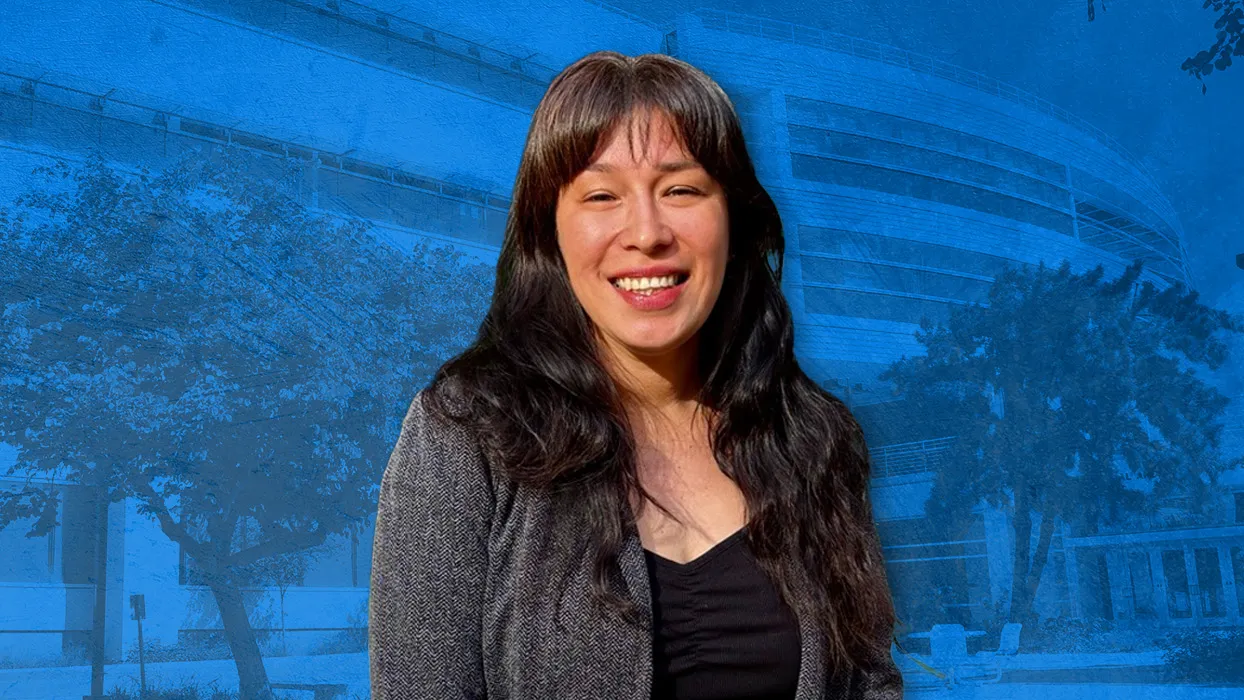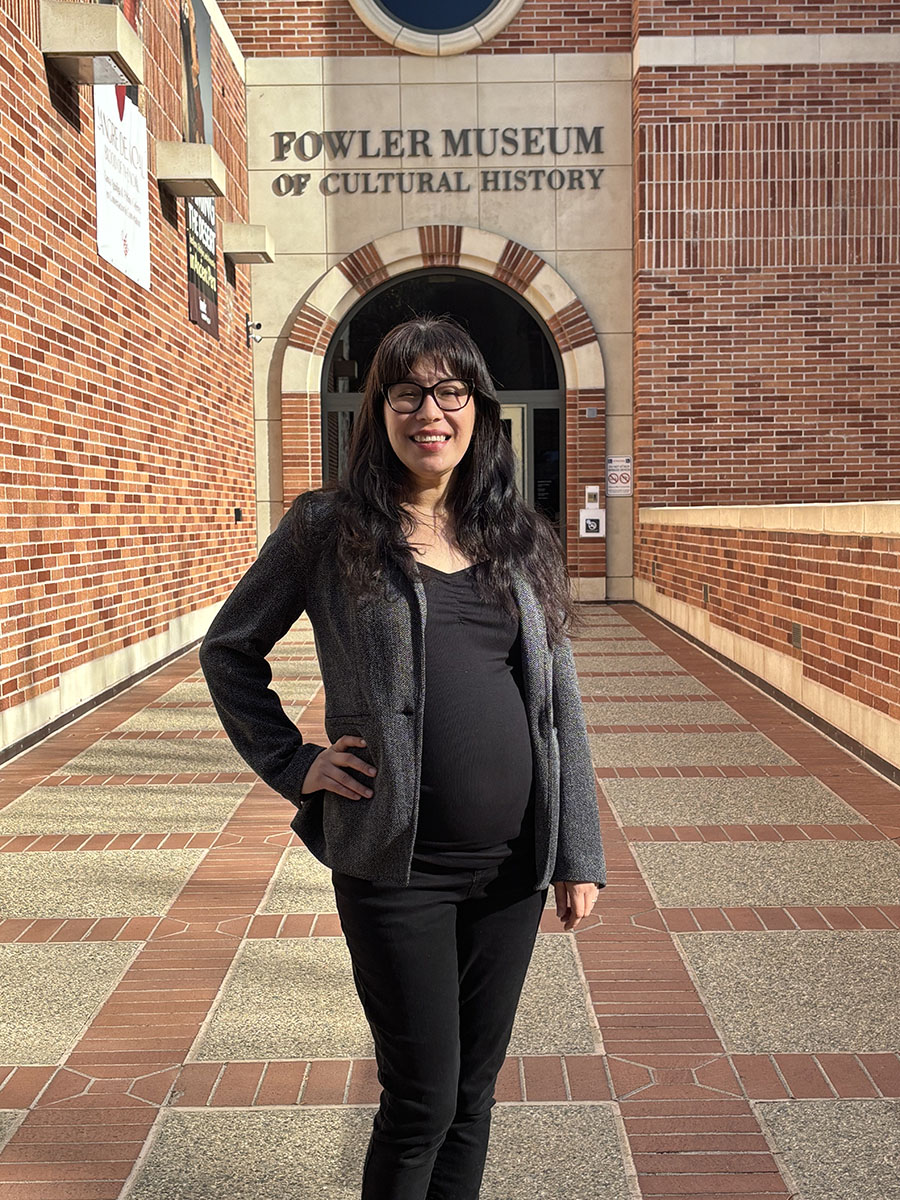Alan Llavore | Office of Marketing and Communications | (909) 537-5007 | allavore@csusb.edu

The academic pursuits of Daisy Ocampo Diaz, assistant professor of history, reflect the classic hero’s journey — venturing into the unknown, uncovering wisdom and returning to empower and uplift her community, inspiring transformation and unity.
Ocampo Diaz (Caxcan, or Caz’ Ahmo, Indigenous Nation of Zacatecas, Mexico) was raised in the Inglewood area of Los Angeles, “what we call a Caxcan satellite community, the place where we gather, have community meetings, fundraisers and other events,” she said. “It’s a very significant cultural place where so much of our community settled.”
Community, place and empowerment are themes that have dominated Ocampo Diaz’s academic journey from the outset. She is the author of “Where We Belong: Chemehuevi and Caxcan Preservation of Sacred Mountains” (2023) and is currently working on two major projects: “Pá’čapa: A Mt. Rubidoux Story,” a short documentary film which she co-produced, and “Fire Kinship,” an upcoming exhibit she curated at the UCLA Fowler Museum sponsored by Getty.
“Where We Belong” was in many ways inspired by Ocampo Diaz’s community in Inglewood.
“As an undergrad at UC Riverside, I was like many first-generation students, a little bit in my head about the experience of being in a new environment and navigating all of that,” she said.
Things became clearer at the end of her undergraduate studies, when she returned to Los Angeles.
“Being one of the first college-educated people in our community and family, they requested that I develop a report, some official history, that demonstrates our connection to our creation mountain, which is Tlachialoyantepec,” or Cerro de las Ventanas, in Zacatecas, Mexico. “We are the people of this place, so this place is really critical to us,” she said.
The community had grave concerns. The Instituto Nacional de Antropologia e Historia (National Institute of Anthropology and History), known as INAH in Mexico, had begun preservation plans to make the sacred mountain a tourist destination in an effort to boost the local economy.
That tribal request ultimately led specifically to Ocampo Diaz’s 2019 doctoral dissertation in history, which was later reworked and published as “Where We Belong,” and to her current academic focus on research in Native and public history, as well as to her work with museum exhibits, historical preservation projects and community-based archives.
“INAH denied us access to our mountain. We could no longer have our dances there. We couldn't gather there,” she said. “If you went up the mountain, you needed to go up with the security guard. It was very policed.
“Native people are so often being marginalized out of our own homelands, and our homelands are then reconstructed as these publicly accessible places for everyone else,” she continued. “They're curated for tourism and photos, and they leave us out.”
Following unsuccessful negotiations with INAH, Ocampo Diaz and the Caxcan community shifted their approach from seeking permissions to a focus on internal education and awareness. Ocampo Diaz facilitated a teacher training session to equip educators in the region with the resources to teach Caxcan history, digitizing and sharing primary sources and archival materials that she collected from various countries. This training led to the creation of a module on Caxcan history for local educational use.

Additionally, she held a well-attended book presentation in her community as part of her outreach efforts. The strategy evolved to emphasize self-empowerment and public history, highlighting how Indigenous people are often marginalized from their own lands, which are repurposed for tourism and sensationalized narratives. The initiative aimed to strengthen the community's cultural knowledge and presence without relying on external approval.
Like Tlachialoyantepec, Mount Rubidoux in Riverside, known as Pá’čapa to Serrano, Luiseño, Cahuilla and Tongva indigenous communities, is also considered a sacred site that has become highly politicized.
The site is the focus of “Pá’čapa: A Mt. Rubidoux Story,” a short documentary co-produced by Ocampo Diaz and three other native women that premiered at UCR Arts in May.
Ocampo Diaz was invited to join the project to conduct archival research. “It's looking at the same concepts [as Tlachialoyantepec] – the way our public spaces are curated for everyone except native people,” she said. “The iconic Mount Rubidoux is a three-mile recreational loop, and there are plaques and memorials dedicated to all the settlers that came in with no mention of native people.”
All roads and trails are maintained by the city of Riverside and by the Friends of Mount Rubidoux, a nonprofit organization formed by citizen volunteers. The cross at the summit is dedicated to Father Junípero Serra. Most of Mount Rubidoux is owned by the City of Riverside, while nearly one-half acre at the peak became the property of Rivers & Lands Conservancy after the cross attracted a potential lawsuit and the city sold it at auction.
Ocampo Diaz noted that the cross symbolizes the history of conquest and devastation of native communities by Christian missionaries.
“It champions these historic characters and prioritizes the history of colonization on these lands,” she said. “This documentary is really about disrupting that.”
Ocampo Diaz also hopes the documentary will bring an awareness of the native communities’ history on the mountain and of its sacred importance.
“We have been doing some community and classroom screenings, and I'm hoping that at a very bare minimum, which is the same thing my Caxcan community was asking for, is: Can we get increased educational programming? Can we have increased access, not for walking the three-mile recreational loop, but to do songs and dancing up there, that can allow a private two-to-three hours for folks in the native community to connect with that mountain? It has been at least a century since tribes have connected to that mountain,” she said.
Ocampo Diaz hopes her latest project, “Fire Kinship: Southern California Native Ecology and Art,” will also raise awareness of the vital roles that Southern California’s native communities played in land stewardship, community well-being and tribal sovereignty.
She was invited to create and curate the exhibit for PST ART: Art & Science Collide, the largest art event in the U.S., which features more than 70 linked exhibitions and public programs throughout Southern California. The event is supported by more than $20 million in Getty grants.
“Fire Kinship” which opened Jan. 12 at UCLA’s Fowler Museum and will be on display there until July 13, was co-curated by CSUSB history graduate student research assistant Lina Tejeda (Pomo) and Michael Chavez (Gabrieleno-Tongva), former Fowler Museum archaeological collections manager and CSUSB NAGPRA program manager.
Ocampo Diaz said it was an honor to be asked to curate the exhibit, which has been in the making for nearly two years. It “reintroduces fire as a generative element, one that connects us to our past and offers a collective path toward a sustainable future,” she said.
“‘Fire Kinship’ looks at the revitalization of cultural fires in southern California native communities,” she continued. “Back in the day, you had small cultural burns of cultural plant material like juncus that needed to be fired to create, for example, baskets. Juncus grows old and brittle, so small-scale burns were needed to regenerate and renew these plants.”
According to Ocampo, that was how tribal communities managed and stewarded the land before colonization.
“And to an extent, that's how they prevented a lot of these wildfires we have today, which result in high human and economic costs,” she said. “The exhibit is really centering indigenous communities as people who are scientifically knowledgeable and have an answer to issues that affect us today. They have not been centered in this conversation, and they should be and will be.”
Reflecting on her academic career, Ocampo Diaz said that first and foremost, her work must have meaningful and practical value that springs from a need or gap in knowledge that requires attention.
“It’s important to come full circle, to really narrow that gap,” she said, “so if you do learn something, you need to find a way for that information to get back to the communities,” whether it’s through presentations, educational programs, exhibits, rather than just adding another book to the shelves. “It’s about making history come alive.”